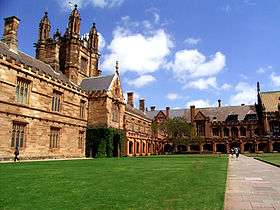University of Sydney
The University of Sydney (USYD, or informally Sydney Uni) is an Australian public research university in Sydney, Australia. Founded in 1850, it is Australia's first university and is regarded as one of the world's leading universities. The university is known as one of Australia's 6 sandstone universities. Its campus is ranked in the top 10 of the world's most beautiful universities by the British Daily Telegraph and The Huffington Post, spreading across the inner-city suburbs of Camperdown and Darlington.[4][5] The university comprises nine faculties and university schools, through which it offers bachelor, master and doctoral degrees.
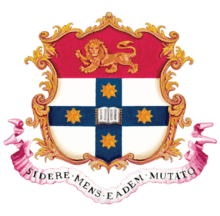 Coat of arms of the University of Sydney[1] | |
| Motto | Sidere mens eadem mutato (Latin) |
|---|---|
Motto in English | The stars change, the mind remains the same |
| Type | Public research university |
| Established | 1850 |
| Endowment | A$2.5 billion (2018)[2] |
| Chancellor | Belinda Hutchinson |
| Vice-Chancellor | Michael Spence |
| Visitor | Governor of New South Wales ex officio |
Academic staff | 3,559 (2018)[3] |
Administrative staff | 4,386 (2018)[3] |
| Students | 61,309 (2018)[3] |
| Undergraduates | 35,351 (2018)[3] |
| Postgraduates | 25,958 (2018)[3] |
| 3,853 (2018)[3] | |
| Location | , NSW , Australia 33°53′16″S 151°11′14″E |
| Campus | Urban, parks |
| Colours | Red, yellow & blue |
| Affiliations | Go8 APRU ASAIHL ACU WUN CEMS |
| Website | sydney |
 | |
In 2018–19, the QS World University Rankings ranked Sydney as one of the world's top 25 most reputable universities,[6] and its graduates as the top 5 most employable in the world and first in Australia.[7] It is one of the first universities in the world to admit students solely on academic merit, and opened their doors to women on the same basis as men.[8]
Five Nobel and two Crafoord laureates have been affiliated with the university as graduates and faculty.[9] The university has educated seven Australian prime ministers, two governors-general of Australia, nine state governors and territory administrators, and 24 justices of the High Court of Australia, including four chief justices. Sydney has produced 110 Rhodes Scholars and 19 Gates Scholars.
The University of Sydney is a member of the Group of Eight, CEMS, the Association of Pacific Rim Universities (APRU), the Association of Commonwealth Universities and the Worldwide Universities Network.
History
1850–1950

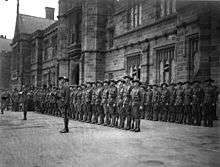
In 1848, in the New South Wales Legislative Council, William Wentworth, a graduate of the University of Cambridge and Charles Nicholson, a medical graduate from the University of Edinburgh Medical School, proposed a plan to expand the existing Sydney College into a larger university. Wentworth argued that a state secular university was imperative for the growth of a society aspiring towards self-government, and that it would provide the opportunity for "the child of every class, to become great and useful in the destinies of his country".[10] It would take two attempts on Wentworth's behalf, however, before the plan was finally adopted.
The university was established via the passage of the University of Sydney Act,[11] on 24 September 1850 and was assented on 1 October 1850 by Sir Charles Fitzroy.[12] Two years later, the university was inaugurated on 11 October 1852 in the Big Schoolroom of what is now Sydney Grammar School. The first principal was John Woolley,[13] the first professor of chemistry and experimental physics was John Smith.[14] On 27 February 1858 the university received its Royal Charter from Queen Victoria, giving degrees conferred by the university rank and recognition equal to those given by universities in the United Kingdom.[15] By 1859, the university had moved to its current site in the Sydney suburb of Camperdown.
In 1858, the passage of the electoral act provided for the university to become a constituency for the New South Wales Legislative Assembly as soon as there were 100 graduates of the university holding higher degrees eligible for candidacy. This seat in the Parliament of New South Wales was first filled in 1876, but was abolished in 1880 one year after its second member, Edmund Barton, who later became the first Prime Minister of Australia, was elected to the Legislative Assembly.
Most of the estate of John Henry Challis was bequeathed to the university, which received a sum of £200,000 in 1889. This was thanks in part due to William Montagu Manning (Chancellor 1878–95) who argued against the claims by British Tax Commissioners. The following year seven professorships were created: anatomy; zoology; engineering; history; law; logic and mental philosophy; and modern literature.
A significant figure from 1927 to 1958, termed 'Sydney's best known academic',[16] was the Professor of Philosophy at the University John Anderson. A native of Scotland, Anderson's controversial views as a self-proclaimed Atheist and advocate of free thought in all subjects raised the ire of many, even to the point of being censured by the state parliament in 1943.[16]
1950–2000
The New England University College was founded as part of the University of Sydney in 1938 and later separated in 1954 to become the University of New England.
During the late 1960s, the University of Sydney was at the centre of rows to introduce courses on Marxism and feminism at the major Australian universities. At one stage, newspaper reporters descended on the university to cover brawls, demonstrations, secret memos and a walk-out by David Armstrong, a respected philosopher who held the Challis Chair of Philosophy from 1959 to 1991, after students at one of his lectures openly demanded a course on feminism.[17] The Builders Labourers Federation placed a green ban on the university after two women tutors were not allowed to teach a course but the issue was quickly resolved internally.[18]
The philosophy department split over the issue to become the Traditional and Modern Philosophy Department, headed by Armstrong and following a more traditional approach to philosophy, and the General Philosophy Department, which follows the French continental approach.
Under the terms of the Higher Education (Amalgamation) Act 1989 (NSW)[19] the following bodies were incorporated into the university in 1990:
- Sydney Branch of the Sydney Conservatorium of Music
- Cumberland College of Health Sciences
- Sydney College of the Arts of the Institute of the Arts
- Sydney Institute of Education of the Sydney College of Advanced Education
- Institute of Nursing Studies of the Sydney College of Advanced Education
- Guild Centre of the Sydney College of Advanced Education.
Prior to 1981, the Sydney Institute of Education was the Sydney Teachers College.
The Orange Agricultural College (OAC) was originally transferred to the University of New England under the Act, but then transferred to the University of Sydney in 1994, as part of the reforms to the University of New England undertaken by the University of New England Act 1993[20] and the Southern Cross University Act 1993.[21] In January 2005, the University of Sydney transferred the OAC to Charles Sturt University.
2000–present
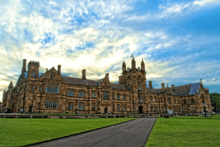
In February 2007, the university agreed to acquire a portion of the land granted to St John's College to develop the Sydney Institute of Health and Medical Research, now the Charles Perkins Centre, the first new research building to be built on campus in over 40 years. As a Roman Catholic institution, in handing over the land St John's placed limitations on the type of medical research which could be conducted on the premises, seeking to preserve the essence of the college's mission. This caused concern among some groups, who argued that it would interfere with scientific medical research. However, this was rejected by the university's administration because the building was not intended for this purpose and there were many other facilities in close proximity where such research could take place..
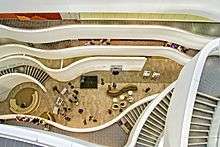
In 2010 the university received a rarely seen Pablo Picasso painting from the private collection of an anonymous donor. The painting, Jeune Fille Endormie, which had never been publicly seen since 1939, depicts the artist's lover, Marie-Thérèse Walter and was donated on the strict understanding that it would be sold and the proceeds directed to medical research.[22] In June 2011, the painting was auctioned at Christie's in London and sold for £13.5 million ($20.6 million AUD). The proceeds of the sale funded the establishment of many endowed professorial chairs at the yet to be constructed Charles Perkins Centre, where a room dedicated to the painting, now exists.[23]
At the start of 2010, the university controversially adopted a new logo. It retains the same university arms, however it takes on a more modern look. There have been stylistic changes, the main one being the coat of arm's mantling, the shape of the escutcheon (shield), the removal of the motto scroll, and also others more subtle within the arms itself, such as the mane and fur of the lion, the number of lines in the open book and the colouration.[24] The original Coat of Arms from 1857 continues to be used for ceremonial and other formal purposes, such as on testamurs.[25][26]
Concerns about public funding for higher education were reflected again in 2014 following the federal government's proposal to deregulate student fees. The university held a wide-ranging consultation process, which included a "town hall meeting" at the university's Great Hall 25 August 2014, where an audience of students, staff and alumni expressed deep concern about the government's plans and called on university leadership to lobby against the proposals.[27] Spence took a leading position among Australian vice-chancellors in repeatedly calling throughout 2014 for any change to funding to not undermine equitable access to university while arguing for fee deregulation to raise course costs for the majority of higher education students.[28][29]
In order to further enhance its competitiveness locally and internationally, the university has introduced plans to consolidate existing degrees to reduce the overall number of programs.[30]
Controversies
In 2001, the University of Sydney chancellor, Dame Leonie Kramer, was forced to resign by the university's governing body.[31] In 2003, Nick Greiner, a former Premier of New South Wales, resigned from his position as chair of the university's Graduate School of Management because of academic protests against his simultaneous chairmanship of British American Tobacco (Australia). Subsequently, his wife, Kathryn Greiner, resigned in protest from the two positions she held at the university as chair of the Sydney Peace Foundation and a member of the executive council of the Research Institute for Asia and the Pacific.[32]
In 2005, the Public Service Association of New South Wales and the Community and Public Sector Union were in dispute with the university over a proposal to privatise security at the main campus (and the Cumberland campus).[33]
Action initiated by Spence to improve the financial sustainability of the university has alienated some students and staff.[34] In 2012, Spence led efforts to cut the university's expenditure to address the financial impact of a slowdown in international student enrolments across Australia. This included redundancies of a number of university staff and faculty, though some at the university argued that the institution should cut back on building programs instead.[35] Critics argue the push for savings has been driven by managerial incompetence and indifference,[34] fuelling industrial action during a round of enterprise bargaining in 2013 that also reflected widespread concerns about public funding for higher education.[36]
An internal staff survey in 2012/13, which found widespread dissatisfaction with how the university is being managed.[37] Asked to rate their level of agreement with a series of statements about the university, 19 per cent of those surveyed believed "change and innovation" were handled well by the university. In the survey, 75 per cent of university staff indicated senior executives were not listening to them, while only 22 per cent said change was handled well and 33 per cent said senior executives were good role models.[38]
In the first week of semester, some staff passed a motion of no confidence in Spence because of concerns he was pushing staff to improve the budget while he received a performance bonus of $155,000 that took his total pay to $1 million, in the top 0.1 per cent of income earners in Australia.[39] Fairfax media reports Spence and other Uni bosses have salary packages worth ten times more than staff salaries and double that of the Prime Minister.[40]
During Spence's term, the university community was divided over allowing students from an elite private school, Scots College, to enter university via a "pathway of privilege" by means of enrolling in a Diploma of Tertiary Preparation rather than meeting HSC entry requirements.[41] The university charged students $12,000 to take the course and have since successfully admitted a number of students to degree courses. An exposé by Fairfax media which turned out to be based on a misunderstanding as to VET and UAC matriculation standards, the scheme has been criticised by Phillip Heath, the national chairman of the Association of Heads of independent schools of Australia.[42]
An investigation by Fairfax Media in 2015 revealed widespread cheating at universities across NSW, including the University of Sydney.[43] The university established a taskforce on academic misconduct in April 2015 to maintain its leadership position in preventing incidences of cheating and academic misconduct.[44]
A 2016 investigation by the Australian Broadcasting Corporation exposed corporate deals between the Veterinary Faculty and large pet food companies had resulted in the withholding of harmful cat food product tested to protect corporate sponsors.[45]
The Institute of Public Affairs’ third (2018) annual audit of free speech on Australian campuses has named the University of Sydney, the Australian National University and James Cook University as the most hostile to free speech based on measures that “aggregate (the) number of problematic policies and actions”.[46] An appendix, provided by the Institute of Public Affairs, listed 51 alleged incidents at 20 universities in which freedom of expression was said to have come under attack. The University of Sydney accounted for the largest (19 out of 51 or 37%) of those alleged incidents. A national code to protect freedom of speech at universities has been endorsed by the federal government. It is intended to counter the risk of overreach by university administrators and aims to restrain rules that stifle opinions that some might consider unwelcome, offensive or even insulting.[47]
In the 2019 Student Experience Survey, the University of Sydney recorded the second lowest student satisfaction rating out of all Australian universities, and the second lowest student satisfaction rating out of all New South Wales universities, with an overall satisfaction rating of 74.2; this was lower than the national average rating of 78.4.[48][49]
Campus
Main campus
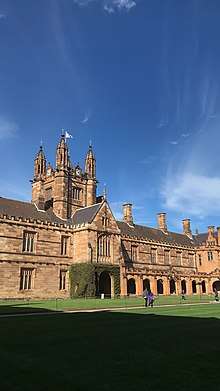
The main campus has been ranked in the top 10 of the world's most beautiful universities by the British Daily Telegraph, and The Huffington Post, among others such as Oxford and Cambridge and is spread across the inner-city suburbs of Camperdown and Darlington.[4][5]
Originally housed in what is now Sydney Grammar School, in 1855 the government granted land in Grose Farm to the university, three kilometres from the city, which is now the main Camperdown campus. In 1854 the architect Edmund Blacket accepted a senate invitation for the first buildings to be designed. In 1858 the Great Hall was finished, and in 1859 the Main Building was built. He composed the original Neo-Gothic sandstone Quadrangle and Great Tower buildings, which were completed in 1862.[50] The rapid expansion of the university in the mid-20th century resulted in the acquisition of land in Darlington across City Road. The Camperdown/Darlington campus houses the university's administrative headquarters, and the Faculties of Arts, Science, Education and Social Work, Pharmacy, Veterinary Science, Economics and Business, Architecture, and Engineering. It is also the home base of the large Sydney Medical School, which has numerous affiliated teaching hospitals across the state.
The main campus is also the focus of the university's student life, with the student-run University of Sydney Union (once referred to as "the Union", but now known as "the USU") in possession of three buildings – Wentworth, Manning and Holme Buildings. These buildings house a large proportion of the university's catering outlets, and provide space for recreational rooms, bars and function centres. One of the largest activities organised by the Union is Welcome Week (formerly Orientation Week or 'O-week'[51]), a three-day festival at the start of the academic year. Welcome Week centres on stalls set up by clubs and societies on the Front Lawns.
The main campus is home to a variety of statues, artworks, and monuments. These include the Gilgamesh Statue and the Confucius Statue.
Some other architects associated with the University were Walter Liberty Vernon, Walter Burley Griffin, Leslie Wilkinson, and the Government Architect's Office.[50] The building was designed in accordance with the university's masterplanning by the architect and founding dean of the university's architecture faculty Leslie Wilkinson, who himself was inspired by a previously unused masterplan developed for the campus by Walter Burley Griffin in 1915.[52]
The 2002 conservation plan of the university stated that the Main Building and Quadrangle, Anderson Stuart Building, Gate Lodges, St Paul's College, St John's College and St Andrew's College "comprise what is arguably the most important group of Gothic and Tudor Revival style architecture in Australia, and the landscape and grounds features associated with these buildings, including Victoria Park, contribute to and support the existence and appreciation of their architectural qualities and aesthetic significance."[50]
In 2015 The NSW Department of Planning and Environment endorsed The University of Sydney's $1.4 billion Campus Improvement Plan which involved a number of new important structures and renovations.[53]
As of 2016 the university is undertaking a large capital works program with the aim of revitalising the campus and providing more office, teaching and student space.[54] The program will see the amalgamation of the smaller science and technical libraries into a larger library, and the construction of a central administration and student services building along City Road. A new building for the School of Information Technologies opened in late 2006 and has been located on a site adjacent to the Seymour Centre. The busy Eastern Avenue thoroughfare has been transformed into a pedestrian plaza and a new footbridge has been built over City Road. The new home for the Sydney Law School, located alongside Fisher Library on the site of the old Edgeworth David and Stephen Roberts buildings, has been completed. The university has opened a new building called "Abercrombie building" for business school students in early 2016.
The NSW state government has reduced transport links to the old campus and the closest Redfern railway station leaving main access to buses on the neighbouring Parramatta Road and City Road, prioritising the growth at other Sydney universities.[55]
From 2007, the university has used space in the former Eveleigh railway yards, just to the south of Darlington, for examination purposes.
In 2018, New South Wales Minister for Heritage, Gabrielle Upton agreed to put the University of Sydney and some adjacent sites on the state heritage register, creating a conservation area that would include the Camperdown campus, and the nearby Victoria Park.[50]
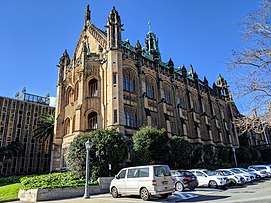 The MacLaurin Hall
The MacLaurin Hall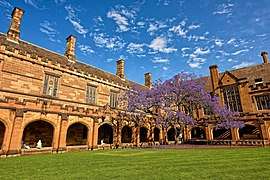 Former jacaranda tree in the main quadrangle
Former jacaranda tree in the main quadrangle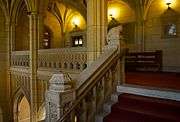 The interior of the Main Quadrangle Southern Range
The interior of the Main Quadrangle Southern Range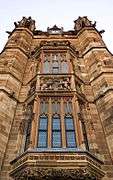 The Great Tower (completed 1862) is on the eastern side of the Main Quadrangle
The Great Tower (completed 1862) is on the eastern side of the Main Quadrangle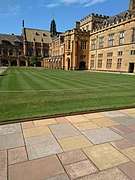 The inside of the University of Sydney Quadrangle in the Summer of 2019
The inside of the University of Sydney Quadrangle in the Summer of 2019
Satellite campuses
- Mallett Street campus: The Mallett Street campus is home of the Sydney Nursing School.
- Cumberland campus: Formerly an independent institution (the Cumberland College of Health Sciences), the Cumberland campus in the Sydney suburb of Lidcombe was incorporated into the university as part of the higher education reforms of the late 1980s. It is home to the Faculty of Health Sciences, which covers various allied health disciplines, including physiotherapy, speech pathology, radiation therapy, occupational therapy, as well as exercise science and behavioural and social sciences in health.
- The Sydney Dental Hospital located in Surry Hills and the Westmead Centre for Oral Health which is attached to Westmead Hospital.
- Rozelle Campus: The Sydney College of the Arts (SCA) is based in a former sanitorium in the Sydney suburb of Rozelle, overlooking Port Jackson. The college specialises in the fine (visual) arts.
- Sydney Conservatorium of Music: Formerly the NSW State Conservatorium of Music, the Sydney Conservatorium of Music (SCM) is located in the Sydney CBD on the edge of Sydney's Royal Botanic Garden, a short distance from the Sydney Opera House. It became a faculty of the university in the 1990s and incorporates the main campus Department of Music, which was the subject of the documentary Facing the Music.
- Camden campus: Located in one of the most rapidly growing peri-urban areas in the country, Sydney's southwest. The Camden campus houses lecture theatres, research institutes, veterinary clinics and research farms for bioscience, environmental science, agriculture and veterinary science.
- Sydney CBD Campus: The University of Sydney Business School CBD Campus is located on Castlereagh Street in the heart of Sydney's CBD close to Town Hall station. The CBD Campus is a convenient, central-Sydney location primarily for participants in the business school's two highly reputed programs - Master of Business Administration (MBA)[56] and Master of Management (MMGT).[57] The CBD Campus has been purpose-designed by award-winning design studio Geyer to facilitate transformative management education.[58]
The university also uses a number of other facilities for its teaching activities.
- Sydney Medical School has eight clinical schools at its affiliated hospitals, responsible for clinical education at the hospitals.
- One Tree Island is an island situated within the World Heritage Site Great Barrier Reef Marine Park about 20 km east-southeast of Heron Island and about 90 km east-northeast of Gladstone on the Queensland coast, and hosts a tropical marine research station of the School of Geosciences.
- The IA Watson Grains Research Centre located at Narrabri in north-central New South Wales is a research station of the Faculty of Agriculture and Environment.
- The Molonglo Observatory is located in the Australian Capital Territory.
- Maningrida is a base camp for scientific expeditions in the Northern Territory.
- Arthursleigh is an agricultural estate located near Goulburn. An art studio is located in Paris, France, while the Australian Archaeology Centre is located in Athens, Greece.
- Taylors College at Waterloo in Sydney is operated by the university for its Foundation Program, catering to international students wishing to enter the university.
 Mallett Street Campus
Mallett Street Campus Centre for Continuing Education
Centre for Continuing Education
Library
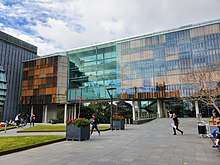
The University of Sydney Library consists of 11 individual libraries located across the university's various campuses. The Fisher and Health sciences libraries offer disability support services.[59] According to the library's publications, it is the largest academic library in the southern hemisphere; university statistics show that in 2007 the collection consisted of just under 5 million physical volumes and a further 300,000 e-books, for a total of approximately 5.3 million items.[61] It is also the only university in Australia to be a state legal deposit library[62] according to the Copyright Act 1968 which stipulates that a copy of every printed material published in NSW be sent to the University Library. The Rare Books Library possesses several extremely rare items, including one of the two extant copies of the Gospel of Barnabas and a first edition of Isaac Newton's Philosophiae Naturalis Principia Mathematica.
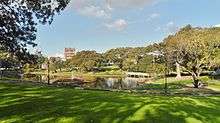
Centre for Continuing Education
The Centre for Continuing Education is an adult education provider within the university. Extension lectures at the university were inaugurated in 1886,[63] 36 years after the university's founding, making it Australia's longest running university continuing education program.[64]
Museums and galleries
The University's significant art, natural history and antiquities collections are organised into a number of collections.
- The Nicholson Museum of Antiquities contains the largest and most prestigious collection of antiquities in Australia. The museum was founded in 1860 by the donation of Sir Charles Nicholson (Sydney University's second chancellor 1854-1862). It is also the country's oldest university museum, and features ancient artefacts from Egypt, the Middle East, Greece, Rome, Cyprus and Mesopotamia, collected by the university over many years and added to by recent archaeological expeditions. The museum is located in the historic Main Quadrangle at the University of Sydney and open freely to general public.
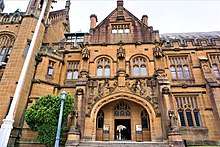
- The Macleay Museum is named after Alexander Macleay, whose collection of insects begun in the late eighteenth century was the basis upon which the museum was founded. It has developed into an extraordinary collection of natural history specimens, ethnographic artefacts, scientific instruments and historic photographs.
- The University Art Collection was founded in the 1860s and contains more than 7,000 pieces, constantly growing through donation, bequests, and acquisition. It is housed in several different places, including the Sir Hermann Black Gallery and the War Memorial Art Gallery.
- The University Art Gallery opened in 1959. The Gallery hosted numerous exhibitions until 1972, when it was taken over for office space. It reopened in 1995 and continues to present a regularly changing program.[65]
- The Rare Books Library is a part of the Fisher Library and holds 185,000 books and manuscripts which are rare, valuable or fragile, including eighty medieval manuscripts, works by Galileo, Halley and Copernicus and an extensive collection of Australiana. The copy of the Gospel of Barnabas, and a first edition of Philosophiae Naturalis Principia Mathematica by Sir Isaac Newton are held here. Regular exhibitions of rare books are held in the exhibition room.
In late 2020, a new museum will open and will combine the Nicholson, Macleay and University Art collections into one institution called the Chau Chak Wing Museum. The new museum is named after Chau Chak Wing, a Chinese businessman.
Halls of residence and residential colleges
The university has a number of halls of residence (based on research-lead living-learning principles) and residential colleges, each with its own distinctive style and facilities. All offer a wide range of cultural, social, sporting and leadership activities along with targeted academic support in a supportive communal environment. The Halls of Residence are owned and operated by the University Accommodation Service.[66] Starting in 2013, the University committed to creating the Halls of Residence (an additional 4,000-6,000 residential places) at an affordable price to enhance the educational experience of living on campus and to offer more students a rich academic environment in which to live.[67]
- The Queen Mary Building[68]
- Abercrombie Student Accommodation
- Regiment Hall (Opening in 2018)
The University Student Accommodation Service were awarded the Asia-Pacific Student Housing Operation of the Year & Excellence in Facility Development and Management[69] in 2016.
The Student Accommodation Service and the Mana Yura Student Support Service were the first in Australia to implement an Aboriginal and Torres Strait Islander On-Campus Residence Halls Scholarship Guarantee.[67]
Additionally, the university owns and operates International House.
Affiliated with the university are six religiously denominated colleges. Unlike some residential colleges in British or American universities, the colleges are not affiliated with any specific discipline of study.
- International House
- St John's College
- St Andrew's College
- St Paul's College
- Sancta Sophia College
- Wesley College
- The Women's College
- Mandelbaum House
There is a university-affiliated housing cooperative, Stucco.
The college also publishes a peer-reviewed online journal, Philament,[70] that focuses on work by postgraduate students including creative stories.[71] The journal is supported by an advisory board of faculty members, and is registered by the Australian Commonwealth Department of Education Science and Training (DEST).
Gallery
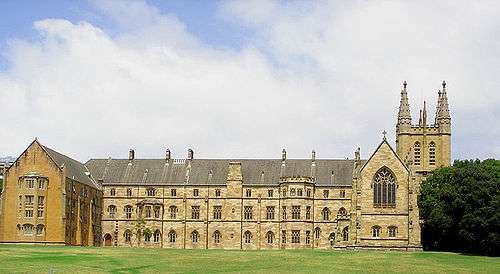 St John's College
St John's College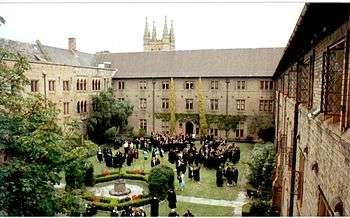 Quadrangle of Sancta Sophia College
Quadrangle of Sancta Sophia College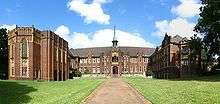 Wesley College
Wesley College- St Andrew's College
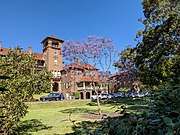 The Women's College
The Women's College
Organisation
The university comprises five faculties and three university schools:[72]
- Faculty of Arts and Social Sciences
- University of Sydney Business School
- Faculty of Engineering
- Faculty of Medicine and Health
- Faculty of Science
- Sydney School of Architecture, Design and Planning
- Sydney Conservatorium of Music
- Sydney Law School
The five largest faculties and schools by 2011 student enrolments were (in descending order): Arts and Social Sciences; Business; Science; Engineering; Health Sciences. Together they constituted 64.4% of the university's students and each had a student enrolment over 4,500 (at least 9% of students).[73]

Academic profile
Rankings
| University rankings | |
|---|---|
| University of Sydney | |
| QS World[74] | 40 |
| THE-WUR World[75] | 60 |
| ARWU World[76] | 80 |
| USNWR World[77] | 27 |
| CWTS Leiden World[78] | 37 |
| Australian rankings | |
| QS National[74] | 2 |
| THE-WUR National[79] | 3 |
| ARWU National[80] | 5 |
| USNWR National[81] | 2 |
| CWTS Leiden National[78] | 3 |
| ERA National[82] | 3[83] |
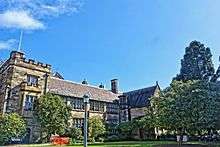
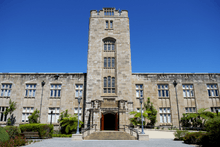
When averaging the world's major rankings, The University of Sydney (56) appears to be ranked third in Australia, behind The University of Queensland (47) and The University of Melbourne (40).[84]
The 2021 QS World University Rankings ranked the University of Sydney 40th in the world,[85] second nationally and top-ranked university in New South Wales. It is ranked 25th in the world by academic reputation.[86] By Subject, QS ranked the University of Sydney in the top 50 across all five broad subject areas.[87]
- 15th in Arts and Humanities
- 39th in Engineering and Technology
- 15th in Life Sciences and Medicine
- 43rd in Natural Sciences
- 14th in Social Sciences and Management
Additionally, Sydney is ranked 2nd in Sports-related Subjects, 10th in Anatomy & Physiology, 11th in Veterinary Science, 12th in Education, 14th in Law and Legal Studies, 15th in Nursing, 16th in Architecture, 18th in Accounting and Finance, 18th in English Language and Literature, 18th in Medicine and 18th in Pharmacy and Pharmacology.
The 2018 QS Graduate Employability Rankings ranked University of Sydney graduates 4th most employable in the world, 1st in Australia, and 2nd in the Asia Pacific region.[88] In 2012, a human resources consultancy in Paris conducted a survey of recruiters in 20 countries and ranked Sydney as 49th in the world for employability.[89]
The Times Higher Education World University Rankings 2019 ranked the University of Sydney 59th in the world and 3rd in Australia, ahead of UNSW at 96th and 5th respectively.[90]
The University of Sydney Business School has cemented its place among the world's leading providers of business education with accreditation from AMBA, a leading authority on postgraduate management studies, thereby achieving the top one percent "triple crown" status.[91]
By subject area, the University of Sydney is ranked:
- 58th in Arts and Humanities
- 37th in Clinical, Pre-clinical and Health
- 76th in Engineering and Technology
- 47th in Life Sciences
- 97th in Physical Sciences
- 68th in Social Sciences
- 83rd in Business and Economics
- 101-125th in Computer Science
- 33rd in Law
- 24th in Education
- 65th in Psychology
The Times Higher Education World Reputation Rankings 2017 ranked Sydney as 61st-70th most reputable in the world.[92]
In 2019, it ranked 33rd among the universities around the world by SCImago Institutions Rankings.[93]
The 2020 US News & World Report's Best Global Universities ranking placed Sydney 27th in the world and 2nd in Australasia.[94] In the 2019 Shanghai Ranking published by the Shanghai Ranking Consultancy, the University of Sydney was ranked in the 80th and in the top 0.6% of universities in the world.[95] Sydney is ranked 1st in Australia and 29th overall in the 2017 CWTS Leiden Rankings for research impact.[96]
In the Performance Ranking of Scientific Papers for World Universities 2015 by National Taiwan University, Sydney is ranked 36th in the world, 3rd in the Asia Pacific and 2nd in Australia.[97]
The prestigious London based Financial Times[98] has ranked the University of Sydney Business School's flagship Master of Management[99] as Australia's number one program of its kind for the seventh consecutive year. The Master of Management (MMgt) program was also ranked in the world’s top 5 for “career progress” made by its graduates.[100]
In terms of alumni wealth, the number of wealthy Sydney alumni was ranked fifth outside the United States, behind Oxford, Mumbai, Cambridge and LSE according to the ABC NEWS.[101] Business magazine Spear's placed the University of Sydney 44th in the world and 2nd in Australia in its table of "World's top 100 universities for producing millionaires".[102]
Endowments and research grants
The university has received a number of significant bequests and legacies over its history. The following are current professorships ("chairs"), funds and fellowships which are funded by bequests and legacies and named after benefactors:
- Douglas Burrows Chair of Paediatrics and Child Health[103]
- John Challis Bequest for chairs in Law, International Law, Jurisprudence, Anatomy, Biology, Civil Engineering, English Literature, History and philosophy (see Challis Professorship)[104]
- Carlyle Greenwell Research Fund in Anthropology and Archaeology[105]
- Edwin Cuthbert Hall Chair of Middle Eastern Archaeology[106]
- Mitchell Notaras Fellowship in Colorectal Surgery[107]
- Robert W Storr Chair for Hepatic Medicine[108]
Coat of arms
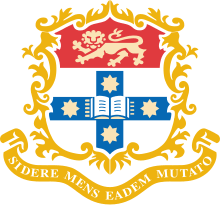
The Grant of Arms was made by the College of Arms in 1857. The grant reads:
- Argent on a Cross Azure an open book proper, clasps Gold, between four Stars of eight points Or, on a chief Gules a Lion passant Guardant also Or, together with this motto "Sidere mens eadem mutato" to be borne and used forever hereafter by the said University of Sydney on their Common Seal, Shields or otherwise according to the Law of Arms.
The use of eight-pointed stars was unusual for arms at the time, although they had been used unofficially as emblems for New South Wales since the 1820s and on the arms of the Church of England Diocese of Australia in 1836.[109]
According to the university, the Latin motto Sidere mens eadem mutato can be translated to "the stars change, the mind remains the same."[1] Francis Merewether, later Vice Provost, in 1857 proposed "Coelum non animum mutant" from Horace (Ep.1.11.27) but after objections changed it to a metrical version including "Sidus" (Star), a neat reference to the Southern Cross and perhaps the Sydney family link with Sir Philip Sidney's "Astrophel (Star-Lover) & Stella (Star)".[110] Author and university alumnus Clive James quipped in his 1981 autobiography that the motto loosely implies "Sydney University is really Oxford or Cambridge laterally displaced approximately 12,000 miles."[111]
Student organisations
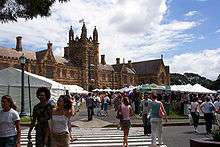
- Student Representatives: Politically and academically, undergraduate students are represented by the Students' Representative Council (SRC) and postgraduate students by the Sydney University Postgraduate Representative Association (SUPRA).
- University of Sydney Union: The University of Sydney Union (USU) is the oldest and largest university union in Australia. USU provides a range of activities, programs, services and facilities geared at giving students the university experience. This involves delivering a huge Clubs and Societies program, a varied entertainment program, student opportunities, a range of catering and retail services plus buildings and recreational spaces for students, staff and visitors.
The SRC and Union are both governed by student representatives, who are elected by students each year. Elections for the USU board of directors occur in first semester; elections for the SRC President, and for members of the Students' Representative Council itself, occur in second semester, along with a separate election for the editorial board of the student newspaper Honi Soit, which is published by the SRC. The elections are usually closely contested, and result in much of the main campus being covered with chalk messages from the various candidates.
Notable alumni
University of Sydney alumni have made significant contributions to Australia and the world.
Notable alumni of Sydney include seven Prime Ministers, the most of any university, three Chief Justices of the High Court, four Federal Opposition Leaders, two Governors-General, nine Federal Attorneys-General, and 24 Justices of the High Court—more than any other law school in Australia. The faculty has also produced 24 Rhodes Scholars and several Gates Scholars. Internationally, alumni of Sydney Law School include the third President of the United Nations General Assembly and a President of the International Court of Justice (in each case, the only Australians to date to hold such positions).
The University of Sydney is associated with five Nobel laureates: in chemistry John Cornforth (alumnus; the only Nobel Laureate born in New South Wales) and Robert Robinson (staff); in economics, John Harsanyi (alumnus); and in physiology or medicine, John Eccles and Bernard Katz (both staff).
The School of Physics has played an important role in the development of radio astronomy in particular:[112] Ruby Payne-Scott conducted the first interferometric observations in radio astronomy with the sea-cliff interferometer at Dover Heights; alumnus Ron Bracewell proposed the nulling interferometer to image extrasolar planets, made contributions to the theory of the Fourier Transform and X-ray tomography, and proposed the idea of the Bracewell probe in SETI; and alumnus Bernard Mills led the construction of the Mills Cross Telescope and Molonglo Observatory Synthesis Telescope in the ACT. School of Physics alumnus and Crafoord Laureate Edwin Salpeter discovered the form of the initial mass function of stars, the importance of beryllium-8 in stellar nuclear fusion, and independently with Yakov Zel'dovich proposed the black hole accretion disk model of active galactic nuclei. The Apollo 14 Mission Scientist Philip K. Chapman and the first Australian-born astronaut to fly in space Paul Scully-Power are both alumni of the University. Chaos theory pioneer and Crafoord Laureate Robert May is an alumnus of and former Professor at the School of Physics, best known for his exploration of the logistic map bifurcations.
In the performing arts, notable alumni include soprano Joan Sutherland; Shakespearean actor John Bell actor, producer and director Dolph Lundgren; and Sri Lankan born Indian actress Jacqueline Fernandez, South Korean singer, producer and director former C-Clown member Rome.
Student well-being
Reports of on-campus sexual assault and harassment
A quarter of the university's female students residing in university colleges have been found to face sexual harassment.[113] Between 2011 and 2016 there were 52 officially reported cases of sexual abuse and harassment on campus released by the university, resulting in 1 expulsion, 1 suspension and 4 reprimands.[114] This is less than the 2017 Australian Human Rights Commission report on sexual assault and harassment which found reported figures substantially higher than this.[115] 71% of students surveyed in 2017 reported not knowing how to make a report relating to sexual assault or harassment. Imogen Grant from the SRC said students who had experienced sexual assault had come forward believing that "navigating the university bureaucracy exacerbates trauma and often seems futile".[116] Previously a 2015 survey of 2000 USyd students found that 57 per cent of respondents did not know where to seek help or how to report sexual misconduct at USyd, and only 1.4% of all serious sexual incidents are reported.[117] After the release of the 2017 report the vice-chancellor said the university was committed to implementing "all of the recommendations contained in the report".[116] Graphic videos emerged in 2018 of male students bragging of their sexual feats over the female students, particularly first-years.[118]
See also
- Frontiers of Science (1962–87)
- Great Hall of the University of Sydney
- Jacaranda (University of Sydney)
- List of universities in Australia
- National Computer Science School
- NICTA – National Information and Communication Technology Research Centre, co-supported by University of Sydney
- Power Institute of Fine Arts
References
Citations
- "Our logo – About the University – The University of Sydney". sydney.edu.au. 19 March 2010. Archived from the original on 22 January 2011. Retrieved 20 June 2010.
- "University of Sydney 2018 Annual Report" (PDF). University of Sydney.
- "Annual Report 2018" (PDF). University of Sydney.
- "Beautiful universities around the world". The Daily Telegraph. London. 31 August 2012.
- "15 of the World's Most Beautiful Universities Revealed". The Huffington Post UK.
- "QS World University Rankings 2019 - Rankings Indicators, Academic Reputation". Top Universities. Retrieved 8 June 2018.
- "Graduate Employability Rankings". Top Universities. Retrieved 14 October 2017.
- "World University Rankings - The University of Sydney". Times Higher Education. Retrieved 8 May 2020.
- "The University of Sydney – QS". Times QS. 2012. Archived from the original on 7 November 2012. Retrieved 1 October 2012.
- "Documenting Democracy". foundingdocs.gov.au.; J. Horne, Political machinations and sectarian intrigue in the making of Sydney University, Journal of the Australian Catholic Historical Society 36 (2015) Archived 15 February 2017 at the Wayback Machine, 4-15.
- "Documenting Democracy". Foundingdocs.gov.au. Archived from the original on 17 October 2009. Retrieved 22 February 2010.
- "William Charles Wentworth". Rockhampton Bulletin. Qld. 21 May 1872. p. 4. Retrieved 1 May 2012 – via National Library of Australia.
- Cable, K. J. "Woolley, John (1816–66)". Australian Dictionary of Biography. Melbourne University Press. ISSN 1833-7538. Retrieved 24 August 2013 – via National Centre of Biography, Australian National University.
- Michael Hoare, Joan T. Radford. "Smith, John (1821–85)". Australian Dictionary of Biography. Melbourne University Press. ISSN 1833-7538. Retrieved 23 August 2013 – via National Centre of Biography, Australian National University.
- Franklin, James 2003, 'Corrupting the Youth: A history of philosophy in Australia', Macleay Press
- West, William (1 January 1992). "Argumentative days over". The Australian. p. 15, Higher Education Supplement.
- "List of green bans, 1971-1974". libcom.org. Retrieved 16 October 2019.
- "HIGHER EDUCATION (AMALGAMATION) ACT 1989". Austlii.edu.au. 20 June 2006. Retrieved 22 February 2010.
- "UNIVERSITY OF NEW ENGLAND ACT 1993". Austlii.edu.au. 22 September 2008. Retrieved 22 February 2010.
- "SOUTHERN CROSS UNIVERSITY ACT 1993". Austlii.edu.au. 22 September 2008. Retrieved 22 February 2010.
- "Donate". The University of Sydney. Retrieved 23 July 2018.
- "News - The University of Sydney". sydney.edu.au. Retrieved 23 July 2018.
- "News | The University of Sydney". sydney.edu.au. 8 January 2010. Retrieved 22 February 2010.
- "Report of the Vice-Chancellor and Principal" (PDF). 15 June 2009. Retrieved 12 June 2011.
- "Sydney Alumni Magazine" (PDF). sydney.edu.au. March 2010. Retrieved 12 June 2011.
- "Overwhelming opposition to fee deregulation at historic University of Sydney town hall meeting". The Sydney Morning Herald. Retrieved 16 July 2015.
- "Middle income families the losers in race to university". The Sydney Morning Herald. Retrieved 16 July 2015.
- "Lateline – 26/08/2014: Universities too reliant on international student fees". ABC. Retrieved 16 July 2015.
- Bagshaw, Eryk (31 March 2016). "University of Sydney to cut 100 degrees and triple research investment". The Sydney Morning Herald. Retrieved 22 March 2018.
- Australian Broadcasting Corporation – PM, Dame Leonie Kramer Resigns. Retrieved 6 January 2007.
- Sydney Morning Herald, Kathryn Follows Nick Out of Door in Protest, 8 November 2003. Retrieved 6 January 2007.
- Public Service Association of NSW, Sydney University Petition on Security Services Archived 4 March 2007 at the Wayback Machine. Retrieved 6 January 2007.
- Max Chalmers (10 March 2014). "The man, the myth, the manager". Retrieved 10 March 2014.
- Stephen Matchett (12 March 2012). "Academics argue VC has not made his case". The Australian. Retrieved 12 February 2013.
- Barnsley, Kate (22 March 2013). "FAQs for Strike Day – March 26 and March 27". Retrieved 24 March 2013.
- Kirsty Needham (9 June 2013). "Sydney Uni staff rank as most dissatisfied"
- "Staff Give Sydney Uni A Poor Grade". Retrieved 14 January 2014.
- Adam Adelpour (16 May 2012). "Michael Spence is the 1 per cent': the role of university management". Solidarity Online..
- Amy McNeilage (23 August 2013). "Uni bosses earn 10 times more than staff". Daily Life..
- "Scots boys got into Sydney University without HSC". The Sydney Morning Herald. Retrieved 16 July 2015.
- "Scots scandal: We don't want elitist, sweetheart deals with universities, says independent school principals chairman Phillip Heath". The Sydney Morning Herald. Retrieved 16 July 2015.
- "The lengths university students will go to cheat". Retrieved 11 August 2015.
- "News – The University of Sydney".
- "Cat food study prompts ethics overhaul at University of Sydney vet faculty". Australia: ABC News. 23 March 2016.
- "Free speech audit names three universities as the 'most hostile'". The Australian. Australia. 10 April 2019.
- "Freedom of speech proposal endorsed". The Australian. Australia. 5 April 2019.
- "2019 Student Experience Survey" (PDF). Retrieved 19 June 2020.
- Baker, Jordan. "UNSW students least satisfied in the country, survey shows". The Sydney Morning Herald. Fairfax Media. Retrieved 19 June 2020.
- "University of Sydney receives state heritage listing". ArchitectureAU. Retrieved 8 May 2019.
- "What's in a name? O-Week becomes Welcome Week". Honi Soit. Retrieved 28/6/19.
- "Grimshaw completes 'gateway' administration building for University of Sydney". ArchitectureAU. Retrieved 14 June 2019.
- "Green light for Sydney Uni's $1.4 billion masterplan". ArchitectureAU. Retrieved 14 June 2019.
- "Campus 2010 + Building for the Future". Facilities.usyd.edu.au. Archived from the original on 6 October 2011. Retrieved 11 October 2011.
- "Sydney Uni lashes out at government over 'serious impact' of train timetable changes". The Sydney Morning Herald. 30 November 2017.
- "MBA". The University of Sydney. Retrieved 16 March 2020.
- "Master of Management". The University of Sydney. Retrieved 16 March 2020.
- "Location and facilities". The University of Sydney. Retrieved 16 March 2020.
- "University of Sydney, Library facilities". Retrieved 17 October 2018.
- "The University of Sydney Statistics 2008" (PDF). University of Sydney. Retrieved 14 January 2009.
- "Legal Deposits in Australia". Retrieved 18 July 2019.
- University of Sydney, Senate Minutes, 5 July 1886, p.291.
- Dymock, Darryl (July 2009). "A reservoir of learning: the beginnings of continuing education at the University of Sydney" (PDF). Australian Journal of Adult Learning. 49 (2): 247. Retrieved 9 August 2015.
- Ellis, David. "Preface", Into the Light: 150 years of cultural treasures at the University of Sydney, Miegunyah Press, University of Sydney, 2010, xiii.
- "Student accommodation". The University of Sydney. Retrieved 6 July 2017.
- "Subsidised accommodation a boost for Sydney Indigenous students". ABC News. 9 March 2017. Retrieved 6 July 2017.
- "University-run accommodation". The University of Sydney. Archived from the original on 22 June 2017. Retrieved 6 July 2017.
- "Past Award Winners - Australasian Association of College and University Housing Officers". www.acuho-i.org. Retrieved 5 December 2018.
- "Philament – About". sydney.edu.au. Archived from the original on 19 April 2014.
- "Beef Jerky" Short Story by Aaron Sommers. 2014 Archived 19 April 2014 at the Wayback Machine
- "Faculties and schools - The University of Sydney". Sydney.edu.au. 20 April 2017. Retrieved 17 May 2017.
- "Sydney University: 2011 Enrolments – All Faculties". Sydney.edu.au. Retrieved 11 October 2011.
- "QS World University Rankings 2021". Quacquarelli Symonds Limited.
- "World University Rankings 2020". TSL Education Limited.
- "Academic Ranking of World Universities 2019". Shanghai Ranking Consultancy.
- "U.S. News and World Report Best Global Universities Rankings". U.S. News and World Report.
- "CWTS Leiden Ranking 2017". Centre for Science and Technology Studies, Leiden University.
- "THE 2020 - Australia". Times Higher Education.
- "Academic Ranking of World Universities 2019 - Australia". Shanghai Ranking Consultancy.
- "U.S. News and World Report Best Global Universities in Australia/New Zealand". U.S. News and World Report.
- "Australian University Rankings". Australian Education Network.
- "ERA Research Excellence Rankings Australia". UniversityRankings. Archived from the original on 12 December 2018. Retrieved 7 December 2018.
- "Group of Eight (Australian universities)", Wikipedia, 5 March 2020, retrieved 5 March 2020
- "QS World University Rankings 2021". Top Universities. 28 May 2020. Retrieved 22 July 2020.
- "QS World University Rankings 2019". topuniversities.com. 29 May 2018. Retrieved 23 July 2018.
- "QS World University Rankings by Subject 2018". Top Universities. Retrieved 1 April 2018.
- "Graduate Employability Rankings 2018". Top Universities. 7 September 2017. Retrieved 1 April 2018.
- "Global Companies Rank Universities - NYTimes.com". New York Times. Retrieved 23 July 2018.
- "World University Rankings". Times Higher Education (THE). 26 September 2018. Retrieved 22 July 2020.
- "Business School achieves 'triple crown' with AMBA accreditation". The University of Sydney. Retrieved 16 March 2020.
- "World Reputation Rankings 2013". Times Higher Education.
- "SCImago Institutions Rankings - Higher Education - All Regions and Countries - 2019 - Overall Rank". www.scimagoir.com.
- "Best Global Universities Rankings". US News.
- "ARWU World University Rankings 2019 | Academic Ranking of World Universities 2019 | Top 1000 universities | Shanghai Ranking - 2019". Shanghai Ranking. Retrieved 22 July 2020.
- "Sydney tops rankings for research impact". The University of Sydney. Retrieved 23 July 2018.
- "National Taiwan University Ranking 2015 – (NTURanking 2015)". ntu.edu.tw. Archived from the original on 17 November 2015. Retrieved 14 November 2015.
- "Business school rankings from the Financial Times - FT.com". rankings.ft.com. Retrieved 16 March 2020.
- "Master of Management". The University of Sydney. Retrieved 16 March 2020.
- "Business School remains Australia's leader for business education". The University of Sydney. Retrieved 16 March 2020.
- "Top 20 Global Universities With the Wealthiest Alum". ABC News.
- "World's top 100 universities for producing millionaires". Times Higher Education.
- Douglas Burrows Chair of Paediatrics and Child Health Retrieved 9 August 2014.
- The Challis Bequest Retrieved 9 August 2014.
- Carlyle Greenwell Research Fund (Archaeology) Retrieved 9 August 2014.
- "Gift to Varsity". The Courier-Mail. Brisbane. 6 August 1953. p. 1. Retrieved 9 August 2014 – via National Library of Australia.
- Mitchell J Notaras Fellowship in Colorectal Surgery Retrieved 9 August 2014.
- The Robert W Storr Chair of Hepatic Medicine Retrieved 9 August 2014.
- "The Badge of New South Wales as adopted in 1876". Heritage Council of New South Wales. Archived from the original on 12 March 2011. Retrieved 2 March 2011.
- Services, Archives and Records Management. "Quest for a coat of arms – Heraldry – The University of Sydney". sydney.edu.au. Retrieved 6 May 2016.
- James, Clive (1981), Unreliable memoirs, Pan Books, p. 127, ISBN 978-0-330-26463-1
- "University of Sydney Hall of Fame". University of Sydney. Retrieved 25 September 2017.
- Davies, Anne (29 November 2017). "One in four women at University of Sydney colleges is sexually harassed, study finds". The Guardian.
- Funnell, Nina (10 October 2016). "Full list of universities exposed by sexual assault investigation". News Limited. Retrieved 29 July 2017.
- "Unis urged to act as 'shocking' survey reveals half of all students face sexual harassment". ABC News. 1 August 2017. Retrieved 7 August 2017.
- Landis-Hanley, Justine (1 August 2017). "USyd releases results on survey into sexual assault and harassment | Honi Soit". Honi Soit. Retrieved 9 August 2017.
- Munro, Kelsey (18 May 2016). "Under-reporting of sexual assault a serious problem at Sydney University". The Sydney Morning Herald. Retrieved 10 August 2017.
- Funnell, Nina. "Women targeted in vile sex games by male students". News.com.au.
Sources
- Williams, Bruce. Liberal education and useful knowledge: a brief history of the University of Sydney, 1850–2000, Chancellor's Committee, University of Sydney, 2002. ISBN 1-86487-439-2
External links
| Wikimedia Commons has media related to University of Sydney. |
